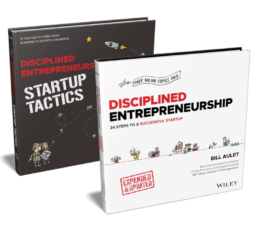Sign up for our newsletter
The Disciplined Entrepreneurship Toolbox
Stay ahead by using the 24 steps together with your team, mentors, and investors.
First published in BizEd on November 18, 2019
I first started as the managing director of the Martin Trust Center for MIT Entrepreneurship a decade ago, I thought my job was to help students create more and better startups.
Fortunately, some wiser and more experienced faculty members reminded me that we were part of an educational institution. It made me think of the old adage that states, “It’s better to teach a man to fish than to give him a fish.” We wanted to teach our students not just how to launch single businesses—we wanted to teach them how to think like entrepreneurs.

As a result, we shifted our focus from creating companies to creating entrepreneurs. To that end, we developed programs for individuals we called the “ready-to-go entrepreneurs.” These are students who are determined to create their own standalone startups. As much as it pains me to say it, back then we were in fact creating people whom others might perceive to be like the characters in the television show “Silicon Valley”—except ours had a moral compass and were better at startup success!
In other words, we believed this group represented our own “beachhead market,” the term entrepreneurs use to describe the one market segment that has proven most open to their products or services. We believed the purpose of teaching entrepreneurship was to train students to build startups.
A funny thing happened, however, as we started to succeed in this strategy. Students who didn’t identify as ready-to-go entrepreneurs—our primary market, remember—would tell us our programs and content helped them as well. People who were interested in building entrepreneurial ecosystems in government, academia, or the private sector began taking our courses. These participants didn’t intend to create startups, but, rather, to be active “entrepreneurship amplifiers”—the term we coined for members of this group. These amplifiers intended to support and promote entrepreneurial behaviors by building ecosystems of individuals and organizations that foster the creation of more startups in a region.
Interestingly, we next discovered that what students learned in our entrepreneurial programs was valuable even outside the startup arena. For example, one of my graduate students, a professional pianist turned e-commerce entrepreneur, told me that she reconnected with her joy of music by applying entrepreneurial principles to the planning and marketing of a campus piano concert. The reason? By first developing a targeted clientele profile, she found that organizing the logistics and content of the event was a much clearer and more manageable task. Her anxiety level before the concert went down and her satisfaction level afterward increased. For the first time, she said, she felt in charge of the process and better aligned with the concert’s mission.
It was a revelation for me that the principles of startup success could be applied in such a radically different domain.
Indeed, my understanding of entrepreneurship has evolved. Now, I view it as a mindset (spirit), a skill set (knowledge and capability taught via an apprenticeship approach), and an operating model that people can apply to achieve their goals. It’s a model that our students can apply in any community-based setting where they are utilizing resources that are not under their control.
Put more simply, my goal as an entrepreneurship educator is no longer to create entrepreneurs or grow startups. My goal now is to create antifragile humans and teams.
What does “antifragile” mean, exactly? It’s a term I first heard used by professor and author Nassim Nicholas Taleb, who wrote a book titled Antifragile: Things That Gain from Disorder. When applying his systems analysis to humans, I would describe antifragile people as those who “grow when exposed to volatility, randomness, disorder, and stressors and love adventure, risk, and uncertainty.”
Fragile systems, meanwhile, are people or teams that break when exposed to unexpected events. Ironically, I believe much of the study of management has been about optimizing and de-risking—it has been about making very predictable systems, teams, and individuals. Paradoxically, that approach ultimately creates a world with more fragility in it.
A key insight I took away from Taleb’s book is that antifragile people and teams are not simply those who are “robust” or “resilient.” Robust people and teams are those who “weather the storms” and keep marching straight ahead unaffected. In the practice of management, we often believe that being robust is the desired state for business leaders, but in actuality it is a neutral condition. Robust people and teams maintain their course when faced with adversity or unexpected events. But in our current world, maintaining course is not enough.
We should be promoting antifragility as the desired state in management endeavors. Antifragile systems, people, and teams actually grow stronger in the face of adversity and uncertainty.
We often believe that being robust is the desired state for business leaders, but in actuality it is a neutral condition.
I draw this analogy: We are unlikely to remember the athlete who’s great early in the game when everything is going as planned, but whose performance fades as time goes on and the competition becomes more complicated. But we never forget the player who is a good performer at the start of the game, but then turns into a great player as the game gets more chaotic and the stakes get higher. It’s that player who is the antifragile human being—it’s that player who accomplishes great things.
Speaking at MIT this past spring, GE Chief Innovation Officer Sue Siegel said, “The world will never be as slow as it is today.” She is so right. Neither will it ever be as simple or predictable. The future will be filled with more Brexits, Donald Trumps, technological disruptions, business model disruptions, societal disruptions, and all of the resulting adversities, uncertainties, and unpredictability. The future also will be filled with opportunities for people to come up with new creative solutions.
To deal with future challenges, we will need people who don’t just survive in a chaotic, stressful, and complex world, but thrive. This is why, as management educators, we must make entrepreneurship about much more than startups. An antifragile entrepreneurial mindset is not just a “nice-to-have” skill we can teach to some of our students. It is a “must-have” skill we should be teaching to all of our students. Their future—and ours—depends on it.
The author
Bill Aulet
A longtime successful entrepreneur, Bill is the Managing Director of the Martin Trust Center for MIT Entrepreneurship and Professor of the Practice at the MIT Sloan School of Management. He is changing the way entrepreneurship is understood, taught, and practiced around the world.

The books
This methodology with 24 steps and 15 tactics was created at MIT to help you translate your technology or idea into innovative new products. The books were designed for first-time and repeat entrepreneurs so that they can build great ventures.

How relevant was this article to you?
Click on a star to rate it!
Average rating 4.6 / 5. Vote count: 54
No votes so far! Be the first to rate this post.
We are sorry that this article was not useful for you!
Let us improve this post!
Tell us how we can improve this post?
